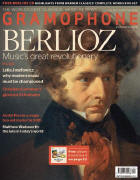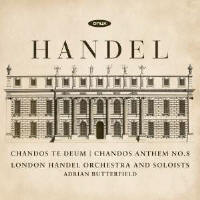Texte paru dans: / Appeared in: |
|
|
Outil de traduction (Très approximatif) |
|
|
Reviewer: David Vickers The longest of Handel’s five settings of the Te Deum canticle was probably composed in 1718 or perhaps early 1719 for performance at St Lawrence’s, Little Stanmore – the parish church of James Brydges, the Earl of Carnarvon (elevated as the Duke of Chandos in April 1719), who paid for its handsome rebuilding in continental Baroque style. While the nearby house Cannons is long gone, the church is preserved gloriously intact, and is the entirely authentic location for the London Handel Orchestra and Adrian Butterfield’s recording (albeit the musicians are not positioned at the east end around the painstakingly restored organ, which is slightly too sharp in pitch to have been used in Fielding only a dozen players and five singers (the peculiar line-up of soprano, three tenors and bass is identical to the near-contemporary Acis and Galatea), this is a rare attempt to perform Handel’s Cannons-period church music with something close to the correct constitution of voices and instruments (perhaps a few boys sang the top part). The only previous recording of the Te Deum (Arte Nova, 1994) was a patchy ‘choral’ account, whereas Butterfield’s slimline performing forces fit the music like a glove. The single voices combine harmoniously in contrapuntal choruses, and unaccompanied passages are shaded poignantly. Charles Daniels’s deft navigation of a stratospheric register interweaves deftly with Nicholas Mulroy’s soaring on the highest tenor parts, Benedict Hymas delivers the lower tenor line articulately, and Edward Grint and Grace Davidson sing the outer parts with intelligent precision. Their conversational transparency is matched by expertly stylish playing. O come, let us sing unto the Lord (circa spring 1718) accords more prominence to solo airs: ‘O come, let us worship’, featuring pairs of pastoral recorders and violins, is sung gorgeously by Daniels; Davidson’s ‘O magnify the Lord’, accompanied intimately by two staccato violins, has hushed sensitivity. The STTB choruses are articulately detailed. Bigger-scale interpretations by The Sixteen (Chandos, 2/90) and the Choir of Trinity College Cambridge (Hyperion, 7/13) both adjusted Handel’s peculiar choral scoring of the anthem for conventional forces – as do almost all recordings of the so-called Chandos Anthems, much to the detriment of their musical aesthetic. Butterfield’s decisions make much better musical sense, and the relaxed sincerity of his musicians yields revelatory new insights. |
|




